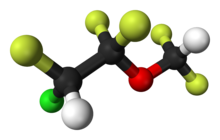エンフルラン
エンフルラン(Enflurane)とはハロゲン化エーテルの一つであり、1970年代から1980年代にかけて吸入麻酔に使用された[1]。1963年にRoss Terrellによって開発され、1966年に臨床的に初めて使用された。経過措置期限2008年3月末を以って販売終了となった[2]。エンフルランはイソフルランの異性体である。エンフルランは容易に揮発するが、室温では液体である。 吸入麻酔薬としてのカラーコードはオレンジ。製品容器や専用気化器にはオレンジの色帯があった。
 | |
 | |
| IUPAC命名法による物質名 | |
|---|---|
| |
| 臨床データ | |
| Drugs.com | Micromedex Detailed Consumer Information |
| 薬物動態データ | |
| 血漿タンパク結合 | 97% |
| 識別 | |
| CAS番号 |
13838-16-9 |
| ATCコード | N01AB04 (WHO) |
| PubChem | CID: 3226 |
| IUPHAR/BPS | 7175 |
| DrugBank |
DB00228 |
| ChemSpider |
3113 |
| UNII |
91I69L5AY5 |
| KEGG |
D00543 |
| ChEBI |
CHEBI:4792 |
| ChEMBL |
CHEMBL1257 |
| 化学的データ | |
| 化学式 | C3H2ClF5O |
| 分子量 | 184.492 g/mol |
| |
特性 編集
| 特性 | 値 |
|---|---|
| 1気圧での沸点 | 56.5 ℃ |
| 最小肺胞内濃度(MAC) | 1.68 |
| 20℃における蒸気圧 | 22.9 kPa (172 mm Hg) |
| 血液・ガス分配係数 | 1.9 |
| 油・ガス分配係数 | 98 |
副作用 編集
臨床的に、エンフルランは用量依存的に心筋収縮力を低下させ、心筋の酸素消費量を減少させる。
エンフルランとメトキシフルランの代謝物は腎毒性を持ち、急性腎不全を引き起こす[3]。エンフルランはイソフルランよりも代謝によって脱フッ素化されやすいので、腎毒性を起こしやすい(生体内代謝率はイソフルランが0.2%なのに対しエンフルランは2%[4])。
エンフルランは痙攣閾値を低下させるので、てんかん患者に使用してはならない。悪性高熱症を惹起する事も知られている。
妊婦に用いると子宮が弛緩する。
膜受容体に対する作用 編集
エンフルランはイソフルランと同じくニューロンレベルにおいて、抑制性の受容体であるGABAA受容体を活性化し、興奮性の受容体であるニコチン性アセチルコリン受容体を抑制する一方で、NMDA型グルタミン酸受容体に対する作用はあまりないことが知られている[5]。
出典 編集
- ^ Niedermeyer, Ernst; Silva, F. H. Lopes da (2005). Electroencephalography: Basic Principles, Clinical Applications, and Related Fields. Lippincott Williams & Wilkins. p. 1156. ISBN 978-0-7817-5126-1
- ^ “経過措置医薬品告示情報”. DATA iNDEX (2007年11月22日). 2016年5月27日閲覧。
- ^ G. Edward Morgan, Maged S. Mikhail, Michael J. Murray, C. Philip Larson (2001). Clinical Anaesthesiology third edition. McGrawHill. p. 142. ISBN 9780838515532
- ^ 熊澤光生; 標準麻酔学 第5版(医学書院), 39頁
- ^ 熊澤光生; 標準麻酔学 第5版(医学書院), 26頁